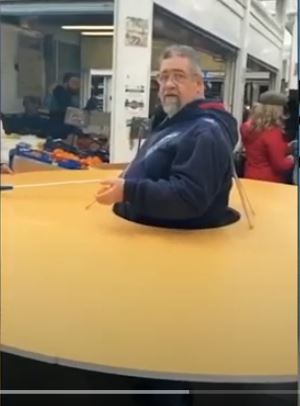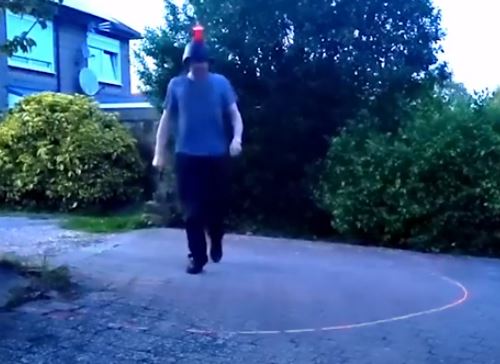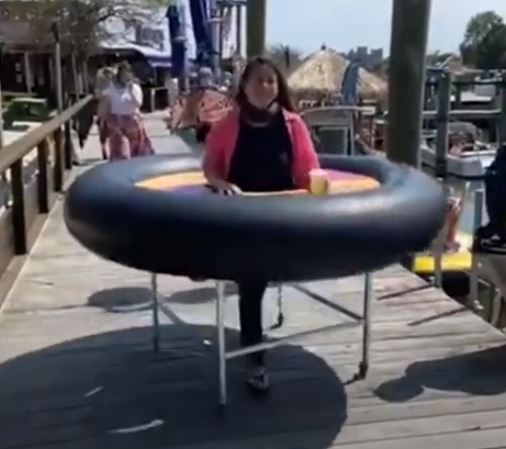Design & Build a Wearable Social Distancing Device

Social distancing in the park (elenabs, iStockphoto)
Students will design and build a wearable prototype that would help to enforce the 2 m social distancing recommendation during the school day.
Overview
Students design and build a wearable device that helps to identify a safe social distance.
Timing
60-90 minutes
Setting the Stage
Context
It has been recommended that maintaining a social distance of 2 metres between people is one way to limit the spread of COVID-19. Knowing if you are 2 metres away from another person at any given point in a school day can be difficult.
In this Design & Build challenge, students will develop their Design & Build skills as they create a wearable prototype that would help to enforce this recommendation during the school day. This challenge provides excellent opportunities for students to practice design planning and process planning skills, as well as idea generation for problem solving, decision making, spatial reasoning and measurement skills.
This Design & Build challenge could begin from:
- questions and/or comments that arise from students about COVID-19 and social distancing, such as:
- "Why do we have to wash our hands so much?"
- "Can kids get sick too?"
- "Why do we have to wear masks?"
- "If I don’t feel sick, why do I have to stay away from my friends?"
- exploring photos or videos of ways that people have already developed to indicate a social distance around themselves.



- Discuss using questions such as:
- “What did people use to make their device?”
- “How are these devices similar? How are they different?”
- “How practical do you think each device is?”
- “What are the strengths and weaknesses of each device?”
Design Criteria
Design and build a wearable prototype that would help to enforce the 2 metres social distancing recommendation during the school day.
Design criteria examples:
The prototype must;
- enforce 2 metres of distance (front, back, and sides)
- be removable;
- be collapsible (has to fit through doorways and be easy to navigate around objects in a room);
- have accessibility to all components for proper cleaning/disinfecting;
- be lightweight enough to wear comfortably for extended periods of time (max 2kg);
- be able to be worn on body or head/neck and allow for hands-free; and
- not limit visibility.
Details
- cardboard boxes
- fasteners (masking tape, transparent tape, elastic bands, etc)
- magnets
- paper clips
- pipe cleaners
- string/wool/ribbon
- plastic tubing
- paper straws
- paper plates
- paper cups
- metre sticks
- wooden craft sticks
- cardstock
- aluminum foil
- Other objects found around school or home
Note: These are only suggested materials. Teachers should modify the materials to suit the needs and accessibility of the learners.
Students develop and apply Design & Build skills as they design, build and test a prototype wearable social distancing device.
Students will follow the steps of the Design & Build process:
- identify the problem to be solved/need to be met
- brainstorm criteria that the prototype must meet
- share their questions and ideas for a solution to the problem/need
- discuss the advantages and disadvantages of each in order to select a potential solution to be tested
- visualize what the solution might look like and make design sketches based on their visualizations
- develop a design plan (e.g., identify the tasks or key steps involved in developing the solution, make decisions about tools and materials that will be needed, include labelled sketches)
- build/develop the design idea based on the design plan
- test their prototypes based on the design criteria
- modify the prototype and retest it against the design criteria as necessary
- reflect on their results and identify things that could be done to improve their prototypes
Observe and document, using anecdotal comments, photos and/or video recordings, student’s ability to:
- Work Collaboratively – students work collaboratively to complete a task and evaluate their group processes throughout the Design & Build process
- Generate Ideas – students use idea generation strategies, such as brainstorming, to identify possible solutions as well as make decisions about the pros and cons of each solution
- Communicate – students communicate their thinking and learning in words/sketches/photos/videos, etc. as they identify problems, do research, develop design plans, and share design solutions
- Work Safely – students demonstrate safe practices when using a variety of tools and materials while prototyping
- Reflect – students reflect on the results of their prototype testing and suggest things that they might do differently to improve their prototypes
|
Students Saying, Doing, Representing |
Educator Interactions: Responding, Challenging |
|
Students identify and refine the problem to be solved/need to be met. |
|
|
Students brainstorm and record criteria for the social distancing wearable |
|
|
Students visualize what the solution might look like and make design sketches based on their visualizations. |
|
|
Students develop a design plan (e.g., steps in creating a prototype, decisions about tools and materials). |
|
|
Students build/develop and test the design idea based on their sketches and design plan (create the prototype). |
|
|
Students modify the prototype and retest it against the design criteria as necessary. |
|
|
Students reflect on the results of their testing and identify things that could be done differently in the future. |
|
Literacy
- Ask questions (e.g., “How easy is it to move around in your device?”, “Why is it important to stay at least 2 m away from each other?”, “What other ways are people using to maintain social distance, such as in stores?”)
- Communicate thoughts, feelings and ideas (e.g., while brainstorming criteria for the game, in design plans that include 2D design sketches, in an outline of key design steps/tasks and lists of required materials and equipment/tools)
- Work collaboratively to come up with solutions (e.g., how to assemble the parts, who will test the prototype)
Mathematical Thinking
- Recognize and use 2D and 3D shapes and figures (e.g., for constructing circular devices like the man wearing the cardboard circle)
- Represent using pictures, diagrams, graphs, tables, numbers, words, and/or symbols (e.g., sketch their visualization of how their device might meet the established criteria)
- Measure and record diameter (e.g., the 2 metre distance between one person and another) and circumference (if creating a circular device)
Visual Arts
- Discuss ways to make the devices appealing to wear
If your students are interested in learning more, the following may provoke their curiosity:
- Investigate ways to create social distance devices for people with physical disabilities.
- “How could you make a physical distance device for someone in a wheelchair or that uses a walker or crutches?”
- “How could you make a physical distance device for someone who is blind or visually impaired?
- Investigate ways to use technology to create devices, like the ones used in these projects
- Arduino device that you can make at home
- Use two micro:bits to help you keep your distance
Materials
- cardboard boxes
- fasteners (masking tape, transparent tape, elastic bands, etc)
- magnets
- paper clips
- pipe cleaners
- string/wool/ribbon
- plastic tubing
- paper straws
- paper plates
- paper cups
- metre sticks
- wooden craft sticks
- cardstock
- aluminum foil
- Other objects found around school or home
Note: These are only suggested materials. Teachers should modify the materials to suit the needs and accessibility of the learners.
What to Do
Students develop and apply Design & Build skills as they design, build and test a prototype wearable social distancing device.
Students will follow the steps of the Design & Build process:
- identify the problem to be solved/need to be met
- brainstorm criteria that the prototype must meet
- share their questions and ideas for a solution to the problem/need
- discuss the advantages and disadvantages of each in order to select a potential solution to be tested
- visualize what the solution might look like and make design sketches based on their visualizations
- develop a design plan (e.g., identify the tasks or key steps involved in developing the solution, make decisions about tools and materials that will be needed, include labelled sketches)
- build/develop the design idea based on the design plan
- test their prototypes based on the design criteria
- modify the prototype and retest it against the design criteria as necessary
- reflect on their results and identify things that could be done to improve their prototypes
Assessment
Observe and document, using anecdotal comments, photos and/or video recordings, student’s ability to:
- Work Collaboratively – students work collaboratively to complete a task and evaluate their group processes throughout the Design & Build process
- Generate Ideas – students use idea generation strategies, such as brainstorming, to identify possible solutions as well as make decisions about the pros and cons of each solution
- Communicate – students communicate their thinking and learning in words/sketches/photos/videos, etc. as they identify problems, do research, develop design plans, and share design solutions
- Work Safely – students demonstrate safe practices when using a variety of tools and materials while prototyping
- Reflect – students reflect on the results of their prototype testing and suggest things that they might do differently to improve their prototypes
Co-constructed Learning
|
Students Saying, Doing, Representing |
Educator Interactions: Responding, Challenging |
|
Students identify and refine the problem to be solved/need to be met. |
|
|
Students brainstorm and record criteria for the social distancing wearable |
|
|
Students visualize what the solution might look like and make design sketches based on their visualizations. |
|
|
Students develop a design plan (e.g., steps in creating a prototype, decisions about tools and materials). |
|
|
Students build/develop and test the design idea based on their sketches and design plan (create the prototype). |
|
|
Students modify the prototype and retest it against the design criteria as necessary. |
|
|
Students reflect on the results of their testing and identify things that could be done differently in the future. |
|
Cross-curricular Connections
Literacy
- Ask questions (e.g., “How easy is it to move around in your device?”, “Why is it important to stay at least 2 m away from each other?”, “What other ways are people using to maintain social distance, such as in stores?”)
- Communicate thoughts, feelings and ideas (e.g., while brainstorming criteria for the game, in design plans that include 2D design sketches, in an outline of key design steps/tasks and lists of required materials and equipment/tools)
- Work collaboratively to come up with solutions (e.g., how to assemble the parts, who will test the prototype)
Mathematical Thinking
- Recognize and use 2D and 3D shapes and figures (e.g., for constructing circular devices like the man wearing the cardboard circle)
- Represent using pictures, diagrams, graphs, tables, numbers, words, and/or symbols (e.g., sketch their visualization of how their device might meet the established criteria)
- Measure and record diameter (e.g., the 2 metre distance between one person and another) and circumference (if creating a circular device)
Visual Arts
- Discuss ways to make the devices appealing to wear
Extending the Learning
If your students are interested in learning more, the following may provoke their curiosity:
- Investigate ways to create social distance devices for people with physical disabilities.
- “How could you make a physical distance device for someone in a wheelchair or that uses a walker or crutches?”
- “How could you make a physical distance device for someone who is blind or visually impaired?
- Investigate ways to use technology to create devices, like the ones used in these projects
- Arduino device that you can make at home
- Use two micro:bits to help you keep your distance